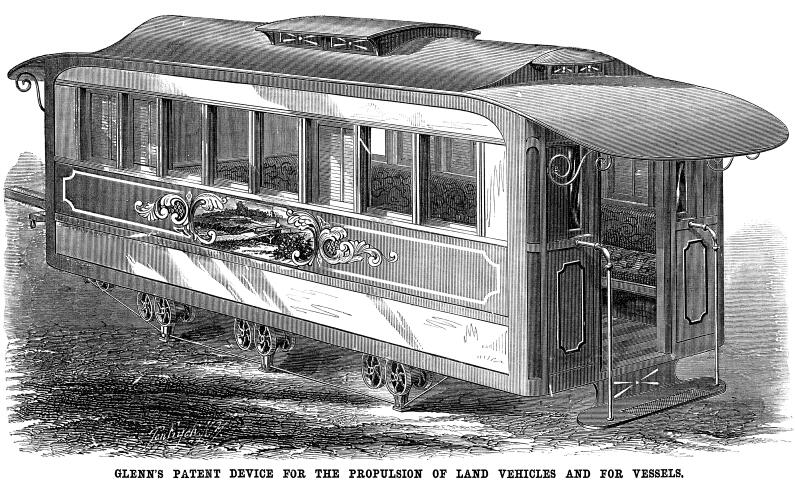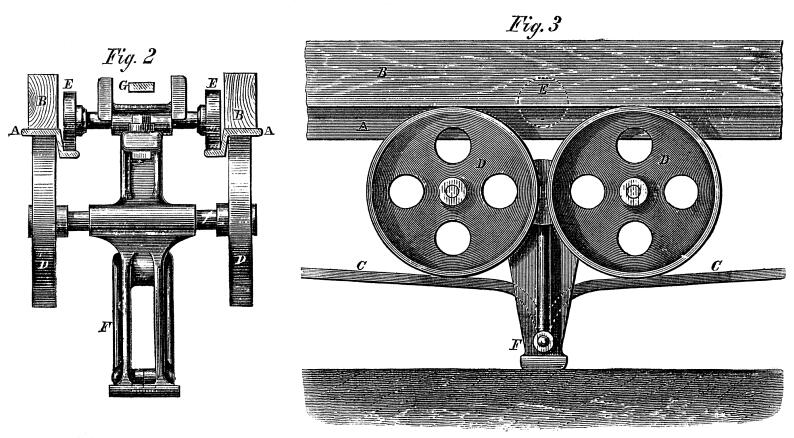Improved Portable Railway.
Scientific American—August 5, 1868
The main principles upon which depend the movements of all
wheeled vehicles are the same, whether like the locomotive and
wheelbarrow the wheel is secured to the axle, or runs freely upon
it as in other vehicles; the rotation of the wheels takes the
carriage forward. But in the device illustrated in the accompanying
engravings everything is reversed; the carriage moves forward
on its wheels, the latter turning against the carriage instead
of against the ground. The contrivance is very simple and quite
unique.

The principal engraving represents a perspective view of a
street car built on this plan; it has a very strong frame and
is really elegant in form. The sides of the frame are of parallel
rails meeting at the ends in a curve, so that the form of the
continuous rail is a flattened oval. The rail, A, which
is of a double angle section as seen in Fig. 2,
is of steel and is firmly bolted to a rim of wood, B, thus
making a side framing of unusual stiffness. To this the sides,
roof, and floor may be secured in any manner desired. Running
on this endless rail are a series of trucks placed at equal distances
apart and connected by steel rods, C, Fig. 3, thus
forming an endless chain. As those on each side of the car are
separate from those on the other side, their action is independent;
this is important in turning curves. The large wheels, D,
have their peripheries in bearing with the outside of the rails,
and are held in close contact by means of the small or keeper
wheels, E. The frames of these trucks extend some distance
beyond the outside rim of the wheels, D, and form a series
of feet, F, which, as the trucks move over the rails or
the rails and car are moved over them, come alternately to the
ground and support the weight of the vehicle. The bottom of the
feet may be made of any width to adapt them to the nature of the
ground over which the carriage may pass; if it is of a soft and
yielding nature the feet should be proportionally broad.
From the foregoing description the operation of the machine
maybe easily comprehended. Whether the power is applied by turning
one of the wheels, D, or by drawing the body of the vehicle
forward by a span of horses, the result will be the same. As the
wheels revolve the carriage moves forward, each truck with its
foot coming down from the top portion of the rail and seating
itself on the ground in front of and under the vehicle, and it
thus remains upright supporting the load until the body of the
car or wagon has been borne over it, when it is taken up at the
rear over the curve and goes forward over the top to repeat the
movement.

For the purpose of turning curves the spindles upon which the
wheels, D and E, revolve are made longer than the
bearings so that the body of the carriage may slide or be steered
to one side or the other. This steering is effected by means of
guide rods—a section seen at G, Fig. 2—which
when operated bear against the sides of the recess in the caps
of the journal of the small or keeper wheel. This operation is
done by the side movement of the pole or shafts to which the draft
animals are attached. There is no more cramping or binding of
the wheels in turning curves or corners than with an ordinary
carriage, as the wheels on either side are entirely independent
one of the other. For public carriages in place of omnibuses or
street cars this plan is intended and seems capable of being adapted,
no permanent track being required. The carriage may be built very
light or as strong as the heaviest freight wagon. It is believed
by the inventor to be specially adapted to agricultural purposes
on moist or swampy ground. Steam power can be easily applied in
place of animal power; for water navigation the inventor claims
that paddles may be substituted for the feet and operate the whole
length of the boat. A boat on this plan is already in process
of construction to be tested on the Erie canal for towing canal
boats at high speeds.
Patented through the Scientific American Patent Agency, Oct.
22, 1867; an other patent is pending on improvements. All communications
for information, etc., to be sent to J. Glenn, 141 Broadway, New
York city. Foreign patents are already secured.
Oddities
| Contents Page
|







